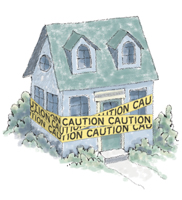There's no place like home, as long as parents prevent it from becoming toxic.
Thoroughly modern parents of the late 20th century might have cracked open a tin of baby formula, poured it into a plastic bottle, and warmed it in a Teflon-coated pan before rushing it to baby's toy-littered nursery. Today's with-it 'rents think twice before exposing their child to-pay attention here, this gets complicated-this following impromptu periodic table of hazardous materials:
1.) From the formula can liner: Bisophenal A (BPA), "linked to breast and prostate cancer and neurobehavioral changes" to babies exposed in the womb," says the Environmental Working Group (EWG).
2.) The bottle: BPA and phthalates, linked to cancer and a higher risk of reproductive system birth defects and hormonal alteration in baby boys and reproductive problems in men.
3.) Teflon pan: Heating this nonstick miracle product releases-say it slowly-perfluorooctanoic acid (PFOA), a "likely carcinogen," and heating the baby's bottle accelerates BPA and phthalates leaching into the formula.
Most homeowners know of the health risks associated with radon, asbestos, lead paint, and lawn pesticides. But how many of us have audited the toxic load of the personal care products we use, the food we eat, and the miscellaneous products and toys we buy for our children?
It's becoming distressingly clear that while some may perceive the world outside to be a threatening place, it ain't much safer inside either. That's owing to outdated standards and the too-cozy relationship between industry and manufacturers and the government entities that were intended to regulate and watchdog them.
Product recalls from manufacturers like Mattel have tipped off most American parents to the threat of lead in children's toys. But if the dread lead weren't enough to drive parents to craft their own homemade Santa's workshops, here's more bad news: A lot of soft plastic toys, often made for the most vulnerable target market in America, teething infants, are composed of the aforementioned BPA and phthalates (as are many plastic food containers, such as those recently pulled from store shelves in Canada).
But the toxic load doesn't end at the teething ring. Last year the EWG found carcinogens in 28 percent of personal care products, including more than 55 percent of baby bubble baths, soaps, and shampoos.
Manufacturers deride the "scare tactics" of environmentalists and cite FDA reports meant to diminish concerns. But those "safe level" standards are coming under increasing scrutiny, and few studies review the long-term impact of the accumulation and interaction of these compounds in our bodies. But here is what we do know: cancer rates in children have been rising since 1975, rates of autism spectrum disorders have skyrocketed, and sperm counts in American men continue a so-far inexplicable decline.
If I lived in a cloud of tobacco smoke from my conception to my cancer-driven doom, not too many folks would be arguing about causation at my mortality and morbidity hearing. Children today are coming of age in a cloud of industrial chemicals. Whether afflicted with autism, leukemia, or genetic abnormalities, they are the wholly blameless canaries in the toxic coalmine of the American home.
What's a properly proactive parent to do? Don't burn your house down; arm yourself with information. Find out what kind of dangerous chemicals are in your home and reduce your exposure to them. Buy your children fewer-but yes, more expensive-properly vetted toys. Visit sites such as Skindeep to find safer products for your home use.
Perhaps most of all pursue your legislators and demand that the agencies that are intended to protect us fulfill their mandate. The 1976 Toxic Substances Control Act grandfathered thousands of potentially dangerous and untested chemicals into widespread use and has at best led to decades of spotty chemical-hazard enforcement. A first step toward practical homefront security would be casting a deeply critical eye on this outdated and badly malfunctioning law.












Add comment